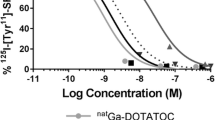Abstract
Scintigraphy with long-acting somatostatin (SST) analogues may be useful for the localization of tumours expressing receptors (R) for SST. In this study we have analysed the in vitro and in vivo binding properties of three SST analogues,123I-octreotide (OCT),123I-Tyr-3-OCT and111In-DTPA-d-Phe-l-OCT. In vitro binding studies performed with a variety of primary tumours (n=48) as well as with several tumour cell lines (A431, HT29, PANC1, COLO320, HMC1, KU812) indicated significant in vitro binding of these three radiolabelled SST analogues to two subpopulations of SSTR, high (K d 0.2–2.0 nM) and low (K d 5–15 nM) affinity ones. The number of SSTR on tumour cells was at least a 1000-fold higher as compared with normal peripheral blood cells. Comparative scintigraphic studies using123I-OCT and/or123I-Tyr-3-OCT and/or111In-DTPA-d-Phe-1-OCT were performed in 21 patients with histologically verified intestinal carcinoid tumours. Corresponding scintigraphic results were obtained in 18 of 21 patients investigated with two different SSTR ligands, either123I-OCT/123I-Tyr-3-OCT (four of five),123I-OCT/111In-DTPA-d-Phe-1-OCT (eight of nine), or123I-Tyr-3-OCT/111In-DTPA-d-Phe-1-OCT (six of seven). We conclude that various tumours express high amounts of SSTR which are recognized by three radiolabelled SST analogues:123I-OCT,123I-Tyr-3-OCT and111In-DTPA-d-Phe-1-OCT. Differences between these SST analogues in their in vitro binding and/or in vivo scanning properties are observed in a minority of patients. Thus, the labelling of OCT with iodine may be an alternative approach for those nuclear medicine departments for which111In-DTPA-d-Phe-1-OCT is not easily available, or is too expensive.
Similar content being viewed by others
References
Reichlin S. Somatostatin.N Engl J Med 1983; 309: 1556–1563.
Brazeau P, Vale W, Burgus R, et al. Hypothalamic polypeptide that inhibits the secretion of immunoreactive pituitary growth hormone.Science 1973; 119: 77–79.
Plewe G, Beyer J, Krause U, et al. Long-acting and selective suppression of growth hormone secretion by somatostatin analogue SMS 201-995 in acromegaly.Lancet 1984; ii: 782–784.
Liebow C, Reilly C, Serrano M, Schally AV. Somatostatin analogues inhibit growth of pancreatic cancer by stimulating tyrosine phosphatase.Proc Natl Acad Sci USA 1989; 86: 2003–2007.
Virgolini I, Yang Q, Li SR, et al. Cross-competition between vasoactive intestinal peptide and somatostatin for binding to tumour cell membrane receptors.Cancer Res 1994; 54: 690–700.
Yamada Y, Post SR, Wang K, et al. Cloning and functional characterization of family of human and mouse somatostatin receptors expressed in brain, gastrointestinal tract, and kidney.Proc Natl Acad Sci USA 1992; 89: 251–255.
Yamada Y, Reisine T, Law SF, et al. Somatostatin receptors, an expanding gene family: cloning and functional characterization of human SSTR3, a protein coupled to adenylyl cyclase.Mol Endocrinol 1992; 6: 2136–2142.
Corness JD, Demchyshyn LL, Seeman P, et al. A human somatostatin receptor (SSTR3), located on chromosome 22, displays preferential affinity for somatostatin-14 like peptides.FEBS Lett 1993; 321: 279–284.
Demchyschyn LL, Srikant CB, Sunahara RK, et al. Cloning and expression of a human somatostatin-14-selective receptor variant (somatostatin receptor 4) located on chromosome 20.Mol Pharmacol 1993; 43: 894–901.
Rohrer L, Raulf F, Bruns C, et al. Cloning and characterization of a fourth human somatostatin receptor.Proc Natl Acad Sci USA 1993; 90: 4196–4200.
Yamada Y, Kagimoto S, Yasuda K, et al. Cloning, functional expression and pharmacological characterization of a fourth (hSSTR4) and fifth (hSSTR5) human somatostatin receptor subtype.Biochem Biophys Res Commun 1993; 195: 844–852.
Kvols LK, Moertel CG, O'Connell MJ, et al. Treatment of the malignant carcinoid syndrome.N Engl J Med 1986; 315: 663–666.
Maton PN, moderator. Somatostatin and somatostatin analogue (SMS 201-995) in treatment of hormone-secreting tumours of the pituitary and gastrointestinal tract and non-neoplastic diseases of the gut.Ann Intern Med 1989; 110: 353–364.
Krenning EP, Bakker WH, Breeman WAP, et al. Localization of endocrine-related tumours with radioiodinated analogue of somatostatin.Lancet 1989; I: 242–244.
Lamberts SWJ, Bakker WH, Reubi JC, et al. Somatostatin-receptor imaging in the localization of endocrine tumors.N Engl J Med 1990; 323: 1246–1249.
Bakker WH, Albert R, Bruns J, et al.111In-DTPA-d-Phe-1octreotide, a potential radiopharmaceutical for imaging of somatostatin receptor-positive tumours: synthesis, radiolabeling and in vitro validation.Life Sci 1991; 49: 1583–1591.
Krenning EP, Bakker WH, Kooij PPM, et al. Somatostatin receptor scintigraphy with indium-111-DTPA-d-Phe-l-octreotide in man: metabolism, dosimetry and comparison with iodine-123-Tyr-3-octreotide.J Nucl Med 1992; 33: 652–658.
Krenning EP, Kwekkeboom DJ, Bakker WH, et al. Somatostatin receptor scintigraphy with123In-DTPA-d-Phe-1 and123I-Tyr-3-octreotide: the Rotterdam experience with more than 1000 patients.Eur J Nucl Med 1993; 20: 716–731.
Eijck CHJ, Krenning EP, Bootsma A, et al. Somatostatin receptor scintigraphy in primary breast cancer.Lancet 1994; 343: 640–643.
Virgolini I, Angelberger P, Li SR, et al.111In-labelled low density lipoprotein (LDL) bind with higher affinity to the human liver as compared to123I-labelled LDL.J Nucl Med 1991; 32: 2132–2138.
Virgolini I, Raderer A, Angelberger P, et al.123I-labeled vasoactive intestinal peptide (VIP) for the localization of intestinal adenocarcinomas and encocrine tumors.N Engl J Med 1994; 331: 1116–1121.
Virgolini I, Li SR, Yang Q, et al. Binding of111In-labeled HDL to platelets from normolipemic volunteers and patients with heterozygous familial hypercholesterolemia.Arteriosclerosis 1982; 12: 849–861.
Virgolini I, Sillaber C, Majdic O, et al. Characterization of prostaglandin binding sites expressed on human blood basophils. Evidence for a prostaglandin E1, I2 and D2 receptor.J Biol Chem 1992; 267: 12700–12708.
Scatchard G. The attractions of proteins for small molecules and ions.Ann NY Acad Sci 1949, 51: 660–672.
Smith-Jones PM, Stolz B, Bruns C, et al. Gallium-67/gallium-68-DFO-octreotide: a potential radiopharmaceutical for PET imaging of somatostatin receptor-positive tumours: synthesis and radiolabeling in vitro and preliminary in vivo studies.J Nucl Med 1994; 35: 317–325.
Krohn KA, Welch MJ. Studies of radioiodinated fibrinogen II. Lactoperoxidase iodination of fibrinogen and model compounds.J Appl Radiat Isotop 1974; 25: 315–325.
Bosee R, Escher E. Synthesis of radioiodinated ligands with high affinity and selectivity for mu- and delta-opioid receptors. In:Peptides 1990. Proc. 21st Eur Pept Symp. Leiden: Escom Sci; 1991; 632–634.
Author information
Authors and Affiliations
Rights and permissions
About this article
Cite this article
Virgolini, I., Angelberger, P., Li, S. et al. In vitro and in vivo studies of three radiolabelled somatostatin analogues:123I-Octreotide (OCT),123I-Tyr-3-OCT and111In-TIRA-d-Phe-1-OCT. Eur J Nucl Med 23, 1388–1399 (1996). https://doi.org/10.1007/BF01367597
Received:
Revised:
Issue Date:
DOI: https://doi.org/10.1007/BF01367597




